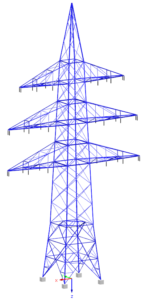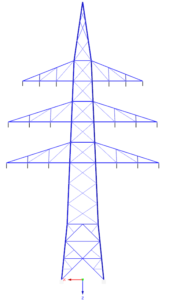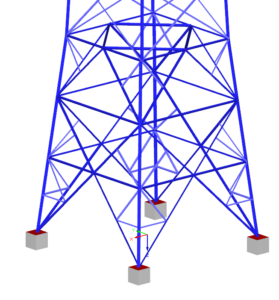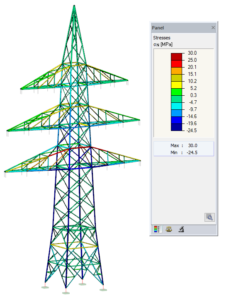
Overhead power lines
Overhead line construction for electrical overhead line networks
Overhead line construction is an important aspect of energy supply in order to ensure low-loss transmission of electricity.
It is the lifeline of our industrialised society and the most important element in the transmission grid of energy suppliers. They ensure low-loss transmission of up to 400,000 volts (380 kV) extra-high voltage and are technically advantageous and significantly more cost-effective than underground cables.
The design of such lattice towers is carried out using 2D and 3D rod models. This allows the individual load combinations to be calculated efficiently. In addition to the permanent loads, wind loads from various directions, snow and ice loads and, where applicable, conductor tensile forces at low temperatures are the most important effects.





Overhead power lines
In the electrical industry, lattice towers are a widely used type of overhead line pylons. They are made of a steel grid composed of several rods and nodes and offer high stability and rigidity with low weight and are manufactured in various sizes and shapes to meet the requirements of power transmission. Calculations of overhead lines are an important aspect in the design of power transmission networks, with the choice of the right mast type and height depending on various factors such as the voltage, the distance between the pylons and the topography of the terrain. The design of lattice towers is an important step in the design of overhead power lines, as they provide a cost-effective and reliable solution for power transmission.
Mobilfunk
Lattice masts are also often used in the mobile communications industry as a support structure for antennas in order to meet the requirements of mobile communications transmission become. Choosing the right mast type and mast height depends on various factors such as the distance between the masts, the topography of the terrain and the frequency of the signal. The construction of lattice masts is an important step in the planning of cellular networks as they represent a cost-effective and reliable solution for cellular transmission.
Poles can be designed as steel or concrete structures. They serve as supports for various systems. They can be used for wind turbines, transmitting antennas, measuring stations or systems for the mobile phone network (5G). At the end of the 20th century, they were used almost exclusively as supports for transmitting antennas.
Our services
In order to ensure the stability of these overhead line pylons for the corresponding service life, the following tasks must be carried out by civil engineers, taking into account all relevant influencing factors. SKI Ingenieurgesellschaft offers the following planning and consulting services for the various types of construction:
- Design and approval planning
- Structural analysis of 2D and 3D truss models
- Evaluation of construction and installation conditions (e.g. stock exchange)
- Detailed evidence (e.g. abutment, grillage calculations)
- Dynamic calculations (natural frequency analysis)
- Calculations in the state of fatigue
- Expertise on the stability

Copyright © 2025
SKI Ingenieurges. mbH
Mengendamm 12
30177 Hannover
Phone: +49 (0) 511 / 261847-0

